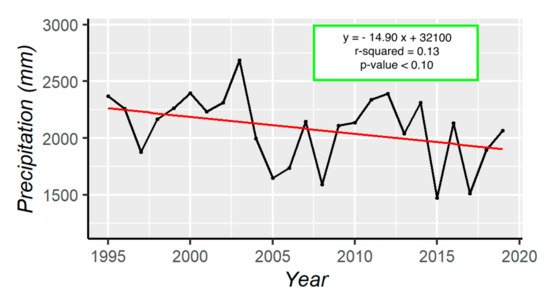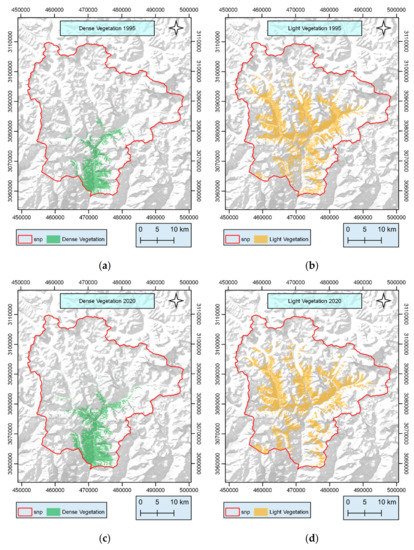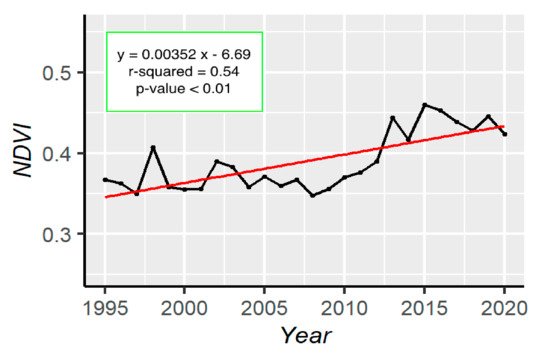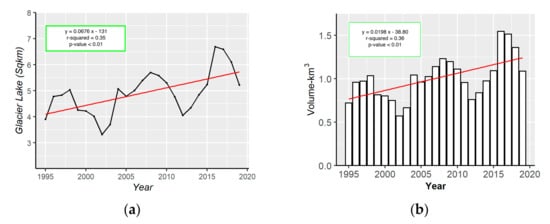The Himalayas, especially the Everest region, are highly sensitive to climate change. Although there are research works on this region related to cryospheric work, the ecological understandings of the alpine zone and climate impacts are limited. This study aimed to assess the changes in surface water including glacier lake and streamflow and the spatial and temporal changes in alpine vegetation and examine their relationships with climatic factors (temperature and precipitation) during 1995–2019 in the Everest region and the Dudh Koshi river basin. In this study, Landsat time-series data, European Commission’s Joint Research Center (JRC) surface water data, ECMWF Reanalysis 5th Generation (ERA5) reanalysis temperature data, and meteorological station data were used. It was found that the glacial lake area and volume are expanding at the rates of 0.0676 and 0.0198 km3/year, respectively; the average annual streamflow is decreasing at the rate of 2.73 m3/s/year. Similarly, the alpine vegetation greening as indicated by normalized difference vegetation index (NDVI) is increasing at the rate of 0.00352 units/year. On the other hand, the annual mean temperature shows an increasing trend of 0.0329 °C/year, and the annual precipitation also shows a significant negative monotonic trend. It was also found that annual NDVI is significantly correlated with annual temperature. Likewise, the glacial lake area expansion is strongly correlated with annual minimum temperature and annual precipitation. Overall, we found a significant alteration in the alpine ecosystem of the Everest region that could impact on the water–energy–food nexus of the Dudh Koshi river basin.
- temperature
- precipitation
- Mann–Kendall test
- surface water
- streamflow
- alpine vegetation
1. Introduction
2. Analysis on Results
2.1. Trends in Climate Variables
2.1.1. Temperature Trend

| Series | Mean Temperature | Maximum Temperature | Minimum Temperature | ||||||
|---|---|---|---|---|---|---|---|---|---|
| z-Value | Tau | p | z-Value | ||||||
| Year | Mean Temperature (Reanalysis vs. Observation) |
Max. Temperature (Reanalysis vs. Observation) |
Min. Temperature (Reanalysis vs. Observation) |
Tau | p | z-Value | Tau | p | |||
|---|---|---|---|---|---|---|---|---|---|---|---|
| t-Value | p-Value | t-Value | p-Value | t-Value | p-Value | ||||||
| Winter | 1.91 | 0.20 | 0.06 | 1.66 | |||||||
2.1.2. Precipitation Trend

| Series | Precipitation | Glacial Lake Area | Mean NDVI | ||||||
|---|---|---|---|---|---|---|---|---|---|
| z-Value | Tau | p | z-Value | Tau | p | z-Value | Tau | zp | |
| -Value | Tau | p | |||||||
| 0.24 | 0.10 | 3.18 | Winter | y = 0.0579x − 123 | R0.29 | <0.01 | |||
| 2 | = 0.08 | ns | |||||||
| Winter | −2.44 | −0.27 | 0.01 | ||||||
| Reference Data Set | User’s Accuracy | ||||||||||||||||||
|---|---|---|---|---|---|---|---|---|---|---|---|---|---|---|---|---|---|---|---|
| Land Cover | Dense Vegetation | Light Vegetation | Other Classes | Total | |||||||||||||||
| 1.64 | 0.24 | 0.10 | 2.23 | ||||||||||||||||
| Winter | 1.24 | 0.18 | 0.45 | ||||||||||||||||
| Classified data set | Dense Vegetation0.22 | <0.01 | 61 | 0 | 0<0.01 | 1.00 | 0.07 | 0.010.03 | 0.95 | ||||||||||
| 61 | 100 | Spring | 0.54 | 0.08 | 0.59 | 1.08 | 0.16 | 0.28 | |||||||||||
| Spring | y = 0.0178x − 35.60 | 1.91 | Spring | −4.31 | −0.360.27 | <0.010.06 | |||||||||||||
| −3.51 | |||||||||||||||||||
| Light Vegetation | −0.31 | 14 | Summer | <0.01 | |||||||||||||||
| R | 2 | = 0.02 | |||||||||||||||||
| Spring | ns | 0.74 | 0.09 | 0.46 | 1.29 | 0.18 | 0.20 | 2.67 | 0.38 | 0.01 | 54 | 0 | 68<0.01 | −2.43 | −0.35 | 0.02 | 3.79 | 0.54 | <0.01 |
| Summer | −1.71 | −0.203.29 | 0.47 | <0.01 | 3.12 | 0.45 | |||||||||||||
| 79.41 | Summer | y = 0.0287x − 49.40 | R2 = 0.46 | Summer*** | −2.340.09 | −0.470.90 | 0.02 | ||||||||||||
| Other Classes | 0 | 21 | 00.540.10 | 0.08 | 0.59 | 21 | 100−3.06 | −0.44 | Autumn | 1.13 | 0.18 | 0.26 | 1.97 | 0.28 | 0.05 | 1.41 | 0.22 | 0.16 | |
| Autumn | y = 0.0279x − 53.60 | R2 = 0.09 | ns | Annual | 1.78 | ||||||||||||||
| Maximum Temperature | 0.26 | 0.07 | 2.27 | 0.33 | 0.02 | 2.46 | 0.35 | 0.01 | |||||||||||
| Climate Variables | Season Variables (y) | Regression Line | R2 | p-Value | ||||||||||||
|---|---|---|---|---|---|---|---|---|---|---|---|---|---|---|---|---|
| Mean Temperature | ||||||||||||||||
| 0.37 | 2.42 | 0.30 | 0.02 | |||||||||||||
| <0.01 | Autumn | −2.06 | −0.32 | |||||||||||||
| Autumn | 0.04 | 3.69 | 0.53 | <0.01 | 3.67 | 0.53 | <0.01 | −3.71 | −0.44 | <0.01 | −0.47 | −0.07 | 0.64 | <0.01 | <0.01 | 1.00 |
| Annual | −2.87 | −0.41 | <0.01 | −0.58 | −0.09 | 0.56 | −3.29 | −0.47 | <0.01 |
2.3. Alpine Vegetation
2.3.1. Spatial Change Detec2tion

| Total | ||||||
| 75 | 75 | 0 | 150 | |||
| Producer’s Accuracy | 89.00 | 72.00 | 0 | 76.33 | ||
2.3.2. NDVI Change Detection

2.4. Alpine Region Change and Its Relationship with Climate Variables
| Response Variables (y) | Multiple Regression Equations |
Seasonal Variables (xij) | R2 | Significance | |||||
|---|---|---|---|---|---|---|---|---|---|
| Annual NDVI | y1 = −0.2869 x1 + 0.0977 x2 + 0.1596 x3 + 0.672 | x1 = annual mean temperature, x2 = annual maximum temperature, x3 = annual minimum temperature |
R2 = 0.65 | *** | |||||
| Annual NDVI with seasons | y1 = −0.2252 x14 + 0.1262 x24 + 0.0944 x34 + 0.00004 x43 + 0.0004 x44 | x14 = autumn mean temperature, x24 = autumn maximum temperature, x34 = autumn minimum temperature x43 = summer precipitation, x44 = autumn precipitation |
R2 = 0.94 | *** | |||||
| Winter NDVI (y11) | y11 = −0.0003 x42 | x42 = spring precipitation, | R2 = 0.92 | *** | |||||
| Summer NDVI (y13) | y13 = −0.2900 x14 − 0.5767 x22 + 0.2117 x24 − 0.0003 x42 − 0.00008 x43 + 0.0008 x44 | x14 = autumn mean temperature, x22 = spring maximum temperature, x24 = autumn maximum temperature, x42 = spring precipitation, x43 = summer precipitation, x44 = autumn precipitation |
R2 = 0.89 | ** | Winter | ||||
| Autumn NDVI (y14 | y = 0.078x − 157 | ) | R | y14 = −0.1673 x23 | x23 = summer maximum temperature | 2 = 0.13 | R | * | |
| 2 | = 0.91 | ** | Spring | y = 0.0181x − 31.50 | R2 = 0.02 | ns | |||
| Surface water | y2 = 1.0399 x3 − 0.0114 x4 | x3 = annual minimum temperature x4 = annual precipitation |
R2 = 0.71 | *** | Summer | y = 0.0343x − 57.80 | |||
| Glacial lake area at summer (y23) | R2 | y23 = −0.0023 x43 | = 0.40 | x | *** | ||||
| 4 | 3 | = summer precipitation | R2 = 0.82 | *** | Autumn | ||||
| Glacial lake area y = 0.0358x − 65 | at autumn (y24) |
y24 = −4.1189 x11 + 2.0369 x21 − 3.0521 xR2 = 0.17 | ** | ||||||
| 22 | − 0.0162 x44 | x11 = winter mean temperature, x21 = winter maximum temperature, x22 = spring maximum temperature, x44 = autumn precipitation |
R2 = 0.93 | *** | Minimum Temperature | Winter | |||
| Spring average | y = 0.0915x − 196 | streamflow (y32) |
y32 = 165.0526 x32 + 0.6938 x44 | R | x32 = spring minimum temperature, x44 = autumn precipitation | 2 = 0.14 | R | * | |
| 2 | = 0.69 | ns | Spring | y = 0.0482x − 102 | R2 = 0.10 | ns | |||
| Summer | y = 0.0341x − 62.90 | R2 = 0.38 | *** | ||||||
| Autumn | y = 0.0467x − 95.50 | R2 = 0.14 | * | ||||||
| Precipitation | Winter | y = −1.49x + 3030 | R2 = 0.06 | ns | |||||
| Spring | y = 0.973x − 1750 | R2 = 0.02 | ns | ||||||
| Summer | y = −12x + 25,800 | ||||||||
| Annual | −2.37 | −0.26 | 0.02 | 2.87 | 0.39 | <0.01 | 2.01 | 0.47 | 0.04 |
| Summer average streamflow (y33) |
y33 = −838.3610 x24 | x24 = autumn maximum temperature, | R2 = 0.76 | ns | |||||
| Spring maximum streamflow (y42) |
y42 = -131.2207 x12 + 111.2719 x32 -148.4615 x34 | x12 = spring mean temperature, x32 = spring minimum temperature, x34 = autumn minimum temperature |
R2 = 0.75 | ns | |||||
| Autumn maximum streamflow (y44) |
y44 = 1.8552 x44 | x44 = autumn precipitation | R2 = 0.79 | ns | |||||
| Annual minimum streamflow |
y5 = −75.6473 x1 − 52.0933 x3 | x1 = annual mean temperature, x3 = annual minimum temperature |
R2 = 0.50 | *** | R2 = 0.09 | ||||
| Winter minimum streamflow (y51) |
y51 = 1.8552 x44 | x44 = autumn precipitation | R2 = 0.68 | ns | ns | ||||
| Spring minimum streamflow (y52) |
y52 = −99.7734 x41 − 0.1012 x42 + 0.2165 x44 | x42 = spring precipitation, x44 = autumn precipitation |
R2 = 0.83 | ns | Autumn | y = −2.46x + 4990 | R2 = 0.11 | ns | |
| Average Streamflow | Winter | ||||||||
| Summer minimum streamflow (y53) |
y53 = 636.6429 x14 − 317.3432 x24 | y = 0.29x − 534 | R2 = 0.09 | ns | |||||
| Spring | y = −2.64x + 5440 | R2 = 0.22 | ** | ||||||
| Summer | y = −11.4x + 23,400 | R2 = 0.34 | *** | ||||||
| Autumn | R2 = 0.35 | *** | |||||||
| y = −2.48x + 5110 | Maximum Streamflow | Winter | y = 0.0713x − 87.60 | R2 ≤ 0.01 | ns | ||||
| Spring | y = −1.07x + 2230 | R2 = 0.10 | ns | ||||||
| Summer | y = 1.05x − 1080 | R2 ≤ 0.01 | ns | ||||||
| Autumn | y = −2.19x + 4630 | R2 = 0.02 | ns | ||||||
| Minimum Streamflow | Winter | y = 0.0779x − 115 | R2 = 0.01 | ns | |||||
| Autumn | y = −0.656x + 1350 | R2 = 0.22 | ** | ||||||
| Summer | y = −4.76x + 9800 | R2 = 0.39 | *** | ||||||
| Autumn | y = −0.0455x + 182 | R2 ≤ 0.01 | ns | ||||||
| Mean NDVI | Winter | y = 0.00338x − 6.45 | R2 = 0.48 | *** | |||||
| Spring | y = 0.00309x − 5.87 | R2 = 0.32 | *** | ||||||
| Summer | y = 0.0026x − 4.76 | R2 = 0.25 | *** | ||||||
| Autumn | y = 0.00506x − 9.74 | R2 = 0.54 | *** | ||||||
| Glacial Lake Area | Winter | y = 0.0784x − 154 | R2 = 0.19 | ** | |||||
| Spring | y = 0.045x − 87.40 | R2 = 0.10 | ns | ||||||
| Summer | y = 0.0346x − 63.90 | R2 = 0.07 | ns | ||||||
| Autumn | y = 0.151x − 295 | R2 = 0.43 | *** |
| 1995 | −1.23 | 0.23 | −1.15 | 0.26 | −0.86 | 0.40 |
2.2. Surface Water
2.2.1. Glacial Lake Changes

2.2.2. Streamflow Trend

| Series | Average Streamflow | Maximum Streamflow | Minimum Streamflow | ||||||
|---|---|---|---|---|---|---|---|---|---|
| z-Value | Tau | p | z-Value | Tau | p | ||||
| x | |||||||||
| 41 | |||||||||
| = winter precipitation, | |||||||||
| x | |||||||||
| 14 | |||||||||
| = autumn mean temperature, | |||||||||
| x | |||||||||
| 24 | |||||||||
| = autumn maximum temperature, | |||||||||
| R | |||||||||
| 2 | |||||||||
| = 0.73 | ns | ||||||||
3. DiscCusrrent Insightsion
3.1. Climate Trend
3.2. Surface Water Dynamics
3.3. Alpine Vegetation Dynamics
References
- Woodward, F.I.; Lomas, M.R.; Kelly, C.K. Global climate and the distribution of plant biomes. Philos. Trans. R. Soc. B Biol. Sci. 2004, 359, 1465–1476.
- Bailey, R.G. Ecoregions: The Ecosystem Geography of the Oceans and Continents; Springer: New York, NY, USA, 2014; ISBN 9781493905232.
- Thornthwaite, C.W. An approach toward a rational classification of climate. Geogr. Rev. 1948, 38, 55–94.
- Korner, C.; Ohsawa, M. Mountain systems. In Ecosystems and Human Well-Being: Current State and Trends; Island Press: Washington, DC, USA, 2005; Volume 1.
- Körner, C.; Paulsen, J.; Spehn, E.M. A definition of mountains and their bioclimatic belts for global comparisons of biodiversity data. Alp. Bot. 2011, 121, 73–78.
- Government of Nepal Nepal Biodiversity Strategy. Available online: https://www.cbd.int/doc/world/np/np-nbsap-01-en.pdf (accessed on 30 July 2021).
- Viviroli, D.; Dürr, H.H.; Messerli, B.; Meybeck, M.; Weingartner, R. Mountains of the world, water towers for humanity: Typology, mapping, and global significance. Water Resour. Res. 2007, 43, 1–13.
- PAN. Temporal and Spatial Variability of Climate Change over Nepal. Available online: https://www.dhm.gov.np/uploads/climatic/467608975Observed%20Climate%20Trend%20Analysis%20Report_2017_Final.pdf (accessed on 30 July 2021).
- ICIMOD/GoN. Nepal Biodiversity Resource Book: Protected Areas, Ramsar Sites, and World Heritage Sites. Available online: https://lib.icimod.org/record/7560 (accessed on 30 July 2021).
- Dixit, A.; Upadhya, M.; Dixit, K.; Pokhrel, A.; Rai, D.R. Living with Water Stress in the Hills of the Koshi Basin, Nepal. Available online: https://www.preventionweb.net/publications/view/12786 (accessed on 30 July 2021).
- Jha, R. Total run-of-river type hydropower potential of Nepal. Hydro Nepal J. Water Energy Environ. 2010, 7, 8–13.
- Masson-Delmotte, V.; Zhai, P.; Pörtner, H.O.; Roberts, D.; Skea, J.; Shukla, P.R.; Pirani, A.; Moufouma-Okia, W.; Péan, C.; Pidcock, R. Global Warming of 1.5 °C. An IPCC Special Report on the Impacts of Global Warming of 1.5 °C above Pre-Industrial Levels and Related Global Greenhouse Gas Emission Pathways, in the Context of Strengthening the Global Response to the Threat of Climate Change. Available online: https://www.ipcc.ch/site/assets/uploads/sites/2/2019/06/SR15_Full_Report_High_Res.pdf (accessed on 30 July 2021).
- Shrestha, A.B.; Wake, C.P.; Mayewski, P.A.; Dibb, J.E. Maximum temperature trends in the Himalaya and its vicinity: An analysis based on temperature records from Nepal for the period 1971–1994. J. Clim. 1999, 12, 2775–2786.
- Ernakovich, J.G.; Hopping, K.A.; Berdanier, A.B.; Simpson, R.T.; Kachergis, E.J.; Steltzer, H.; Wallenstein, M.D. Predicted responses of arctic and alpine ecosystems to altered seasonality under climate change. Glob. Chang. Biol. 2014, 20, 3256–3269.
- Zhang, Y.; Gao, J.; Liu, L.; Wang, Z.; Ding, M.; Yang, X. NDVI-based vegetation changes and their responses to climate change from 1982 to 2011: A case study in the Koshi River Basin in the middle Himalayas. Glob. Planet. Chang. 2013, 108, 139–148.
- Liu, L.; Wang, Y.; Wang, Z.; Li, D.; Zhang, Y.; Qin, D. Elevation-dependent decline in vegetation greening rate driven by increasing dryness based on three satellite NDVI datasets on the Tibetan Plateau. Ecol. Indic. 2019, 107, 105569.
- Baniya, B.; Tang, Q.; Koirala, M.; Rijal, K.; Kattel, G. Growing season vegetation dynamics based on NDVI and the driving forces in Nepal during 1982–2015. For. J. Inst. For. Nepal 2020, 17, 1–22.
- Wu, X.; Sun, X.; Wang, Z.; Zhang, Y.; Liu, Q.; Zhang, B.; Paudel, B.; Xie, F. Vegetation changes and their response to global change based on NDVI in the Koshi River Basin of central Himalayas since 2000. Sustainability 2020, 12, 6644.
- Anderson, K.; Fawcett, D.; Cugulliere, A.; Benford, S.; Jones, D.; Leng, R. Vegetation expansion in the subnival Hindu Kush Himalaya. Glob. Chang. Biol. 2020, 26, 1608–1625.
- Gao, Q.; Guo, Y.; Xu, H.; Ganjurjav, H.; Li, Y.; Wan, Y.; Qin, X.; Ma, X.; Liu, S. Climate change and its impacts on vegetation distribution and net primary productivity of the alpine ecosystem in the Qinghai-Tibetan Plateau. Sci. Total Environ. 2016, 554–555, 34–41.
- Brandt, J.S.; Haynes, M.A.; Kuemmerle, T.; Waller, D.M.; Radeloff, V.C. Regime shift on the roof of the world: Alpine meadows converting to shrublands in the southern Himalayas. Biol. Conserv. 2013, 158, 116–127.
- Mohapatra, J.; Singh, C.P.; Tripathi, O.P.; Pandya, H.A. Remote sensing of alpine treeline ecotone dynamics and phenology in Arunachal Pradesh Himalaya. Int. J. Remote Sens. 2019, 40, 7986–8009.
- Mishra, N.B.; Mainali, K.P. Greening and browning of the Himalaya: Spatial patterns and the role of climatic change and human drivers. Sci. Total Environ. 2017, 587–588, 326–339.
- Bokhorst, S.; Bjerke, J.W.; Melillo, J.; Callaghan, T.V.; Phoenix, G.K. Impacts of extreme winter warming events on litter decomposition in a sub-Arctic heathland. Soil Biol. Biochem. 2010, 42, 611–617.
- Nie, Y.; Liu, Q.; Liu, S. Glacial lake expansion in the Central Himalayas by Landsat Images, 1990–2010. PLoS ONE 2013, 8, e83973.
- Khadka, N.; Zhang, G.; Thakuri, S. Glacial lakes in the Nepal Himalaya: Inventory and decadal dynamics (1977–2017). Remote Sens. 2018, 10, 1913.
- Bajracharya, S.R.; Mool, P. Glaciers, glacial lakes and glacial lake outburst floods in the Mount Everest region, Nepal. Ann. Glaciol. 2009, 50, 81–86.
- Churkina, G.; Running, S.W. Contrasting climatic controls on the estimated productivity of global terrestrial biomes. Ecosystems 1998, 1, 206–215.
- Nemani, R.R.; Keeling, C.D.; Hashimoto, H.; Jolly, W.M.; Piper, S.C.; Tucker, C.J.; Myneni, R.B.; Running, S.W. Climate-driven increases in global terrestrial net primary production from 1982 to 1999. Science 2003, 300, 1560–1563.
- Balling, R.C.; Michaels, P.J.; Knappenberger, P.C. Analysis of winter and summer warming rates in gridded temperature time series. Clim. Res. 1998, 9, 175–181.
- Schuerings, J.; Beierkuhnlein, C.; Grant, K.; Jentsch, A.; Malyshev, A.; Peñuelas, J.; Sardans, J.; Kreyling, J. Absence of soil frost affects plant-soil interactions in temperate grasslands. Plant. Soil 2013, 371, 559–572.
- Kreyling, J.; Grant, K.; Hammerl, V.; Arfin-Khan, M.A.S.; Malyshev, A.V.; Peñuelas, J.; Pritsch, K.; Sardans, J.; Schloter, M.; Schuerings, J.; et al. Winter warming is ecologically more relevant than summer warming in a cool-temperate grassland. Sci. Rep. 2019, 9, 14632.
- Parmesan, C.; Yohe, G. A globally coherent fingerprint of climate change impacts across natural systems. Nature 2003, 421, 37–42.
- Salerno, F.; Guyennon, N.; Thakuri, S.; Viviano, G.; Romano, E.; Vuillermoz, E.; Cristofanelli, P.; Stocchi, P.; Agrillo, G.; Ma, Y.; et al. Weak precipitation, warm winters and springs impact glaciers of south slopes of Mt. Everest (central Himalaya) in the last 2 decades (1994–2013). Cryosphere 2015, 9, 1229–1247.
- Shrestha, A.B.; Bajracharya, S.R.; Sharma, A.R.; Duo, C.; Kulkarni, A. Observed trends and changes in daily temperature and precipitation extremes over the Koshi river basin 1975–2010. Int. J. Climatol. 2017, 37, 1066–1083.
- Zemp, M.; Huss, M.; Thibert, E.; Eckert, N.; McNabb, R.; Huber, J.; Barandun, M.; Machguth, H.; Nussbaumer, S.U.; Gärtner-Roer, I.; et al. Global glacier mass changes and their contributions to sea-level rise from 1961 to 2016. Nature 2019, 568, 382–386.
- Bajracharya, S.R.; Mool, P.K.; Shrestha, B.R. Impact of Climate Change on Himalayan Glaciers and Glacial Lakes: Case Studies on GLOF and Associated Hazards in Nepal and Bhutan; International Centre for Integrated Mountain Development (ICIMOD): Kathmandu, Nepal; United Nations Environment Programme (UNEP): Nairobi, Kenya, 2007.
- Salerno, F.; Thakuri, S.; D’Agata, C.; Smiraglia, C.; Manfredi, E.C.; Viviano, G.; Tartari, G. Glacial lake distribution in the Mount Everest region: Uncertainty of measurement and conditions of formation. Glob. Planet. Chang. 2012, 92–93, 30–39.
- Wang, X.; Siegert, F.; Zhou, A.G.; Franke, J. Glacier and glacial lake changes and their relationship in the context of climate change, Central Tibetan Plateau 1972–2010. Glob. Planet. Chang. 2013, 111, 246–257.
- Water and Energy Commission Secretariat. Water Resources of Nepal in the Context of Climate Change; Water and Energy Commission Secretariat: Kathmandu, Nepal, 2011.
- Gautam, M.R.; Acharya, K. Streamflow trends in Nepal. Hydrol. Sci. J. 2012, 57, 344–357.
- Shi, C.; Sun, G.; Zhang, H.; Xiao, B.; Ze, B.; Zhang, N.; Wu, N. Effects of warming on chlorophyll degradation and carbohydrate accumulation of alpine herbaceous species during plant senescence on the tibetan plateau. PLoS ONE 2014, 9, e107874.
- Li, P.; Zhu, Q.; Peng, C.; Zhang, J.; Wang, M.; Zhang, J.; Ding, J.; Zhou, X. Change in Autumn Vegetation Phenology and the Climate Controls From 1982 to 2012 on the Qinghai–Tibet Plateau. Front. Plant. Sci. 2020, 10, 1677.
- Garrard, R.; Kohler, T.; Price, M.F.; Byers, A.C.; Sherpa, A.R.; Maharjan, G.R. Land use and land cover change in Sagarmatha National Park, a world heritage site in the Himalayas of Eastern Nepal. Mt. Res. Dev. 2016, 36, 299.
- Pandey, P.; Kulkarni, A.V.; Venkataraman, G. Remote sensing study of snowline altitude at the end of melting season, Chandra-Bhaga basin, Himachal Pradesh, 1980–2007. Geocarto Int. 2013, 28, 311–322.
- Chen, X.; An, S.; Inouye, D.W.; Schwartz, M.D. Temperature and snowfall trigger alpine vegetation green-up on the world’s roof. Glob. Chang. Biol. 2015, 21, 3635–3646.
